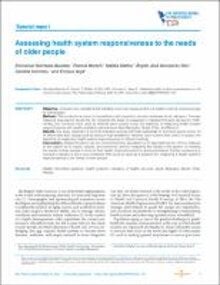Special Report objective: identify key indicators that will allow empirical measurement of a health system’s responsiveness to older people. Methods. We conducted a series of consultations with experts to develop a relevant list of indicators. Concept mapping was used to devise the list, including the steps of preparation, brainstorming and structuring. Additionally, four countries were used as national case studies to test the feasibility of measuring health system responsiveness with readily available national-level data (Barbados, Brazil, Chile, and Mexico). Results. Our study resulted in a list of 25 indicators scored with high usefulness for informing public policy, 10 of which were also categorized as being of high availability. National case studies were useful to assess the feasibility of measuring health system responsiveness in different settings. Conclusions. Responsiveness can be comprehensively assessed by (i) approaching the intrinsic features of the system via its inputs, outputs, and outcomes, and (ii) measuring the impact of the system on meeting the needs of older people in terms of their health, financial protection, and expectations. Further consensus is needed to develop a list of core indicators that could be used as a baseline for measuring a health system’s responsiveness to the needs of older people.
|

